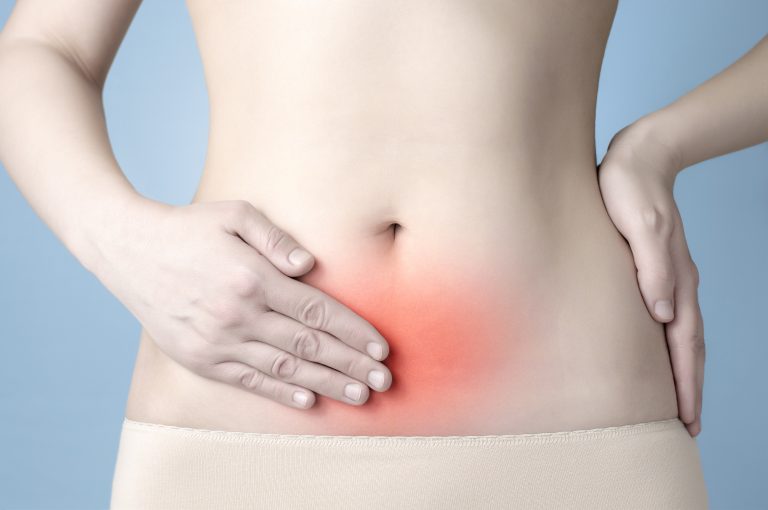Most women experience cramps and menstrual pain from time to time but is the paint caused by your period or Endometriosis? An estimated 1 out of 10 women suffer from Endometriosis in the United States, however many remain undiagnosed.
What is Endometriosis?
Endometriosis affects women and it is a painful disorder. It’s caused when tissue starts to build up around the ovaries, fallopian tubes and pelvis lining. The buildup of tissue can lead to cysts, pain and sometimes fertility problems.
Endometriosis can occur anytime after a woman’s first period, but mostly affects women aged between 25-35. The cause of endometriosis is unknown.
What are the Symptoms of Endometriosis?
Severe Cramps
Many women suffer from cramps during their period, so it can be hard to judge what is ‘normal’ and what is abnormal pain. This is one of the reasons endometriosis often goes undiagnosed. Cramps may be a sign of endometriosis when they prevent you from working or going about your day. And, when cramps are not improved by over-the-counter medicine. Particularly when combined with other symptoms.
Long Periods
Most women have a period that lasts between two and seven days and occurs every 21 to 35 days. If you regularly have your period at shorter intervals or experience prolonged periods, this may be a symptom of endometriosis.
Heavy Menstrual Flow
Heavy bleeding, known as menorrhagia, is usually defined as menstrual bleeding that lasts more than 7 days. It can also be bleeding that is very heavy. If you are changing your pad or tampon at intervals of less than 2 hours or have large visible blood clots the size of a quarter then you may have Menorrhagia.
Bowel and Urinary Disorders
Painful bowel movements or urination, gassiness or diarrhea during your period may all be signs of endometriosis.
Nausea and/or Vomiting
If you experience vomiting, nausea, headaches, or migraines with your period this may be a sign of endometriosis.
Pain During Sexual Activities
Pain during sex can be a sign of endometriosis and may be more severe in different positions. The pain is caused inflammation and fibrosis fusing the front wall of the rectum to the back wall of the vagina. This can be a difficult symptom to discuss with your doctor and partner, but it is important to voice this symptom to get an accurate diagnosis.
Infertility
If you are struggling to conceive, endometriosis could be the cause. Endometriosis can also impact pregnancy and it impacts the ability to carry a pregnancy to full term, with women often suffering miscarriages.
Chronic Fatigue
If you find yourself sleeping or napping more than usual, lacking energy, or feeling dizzy this may be a sign of Chronic Fatigue. Fatigue alone without other symptoms is not necessarily a sign of endometriosis and could be due to many other causes including anemia, thyroid issues or low blood sugar. If you suffer from fatigue, with or without other symptoms, you should speak to your doctor to identify the cause.
Track Your Symptoms
If you’re unsure how severe of frequent your symptoms are you may find it helpful to use a period app to track your period over the course of a few months. Noting the length of periods, the severity of cramps on different days of your cycle, and the frequency of other symptoms, such as nausea or diarrhea, will help you assess your symptoms. There are many free apps that will help you do this, or you can make detailed notes in a diary.
What Do Blood Clots Look Like With Endometriosis?
Endometriosis blood clots may appear as dark or bright red clumps or blobs in menstrual flow. The clots can vary in size and texture, ranging from small and grainy to larger and more jelly-like in consistency. However, it’s important to consider that blood clots during menstruation can also be caused by other conditions and may not always indicate endometriosis. If you are concerned about your menstrual bleeding or other symptoms, it’s important to speak with one of our Women’s health providers for proper evaluation and diagnosis.
Treatment Options for Endometriosis
Treatment options for endometriosis are unfortunately limited, the most common is minimally invasive laparoscopic excision surgery.
However, there are many options for endometriosis relief, but these forms of treatment do not treat the endometriosis itself. Treatment options include acupuncture, changes in diet, the contraceptive pill, a hormonal intrauterine device (IUD), painkillers, or gonadotropin-releasing hormone (GnRH ) therapy.
Unfortunately, many endometriosis patients are misdiagnosed or may suffer from symptoms for a long time before establishing the cause. Tracking your symptoms over a few months and being honest when speaking to your doctor, even about uncomfortable topics such as pain during sex, can help you get the right diagnosis.
More sources:
- https://www.endofound.org/endometriosis
- https://www.healthline.com/health/womens-health/endometriosis-fatigue
- https://www.mayoclinic.org/diseases-conditions/endometriosis/symptoms-causes/syc-20354656
If you would like to meet with a knowledgeable doctor, consider contacting Women’s Health Arizona. As Arizona’s largest ObGyn group, we’re trained and solely dedicated to delivering the best ObGyn experience in convenient and comfortable settings around Phoenix.

